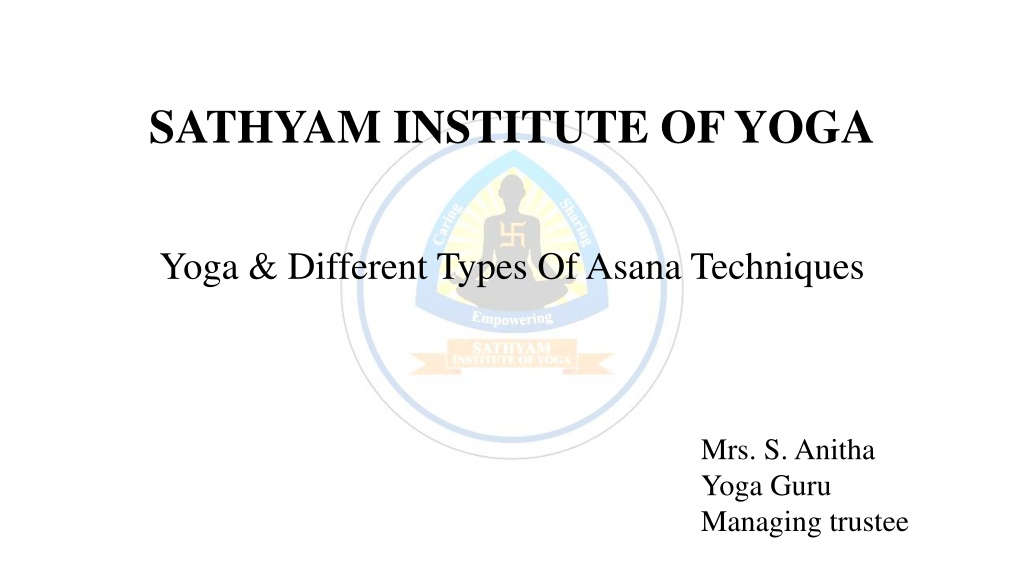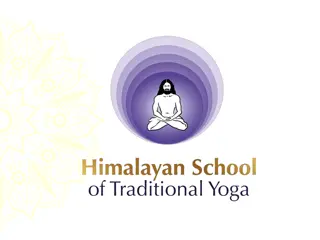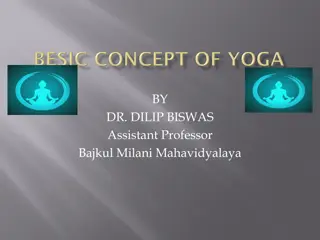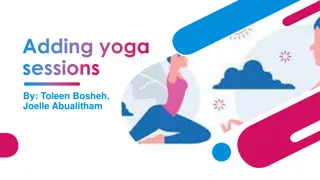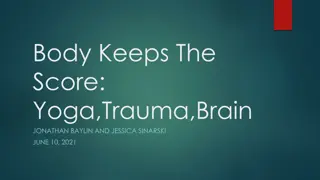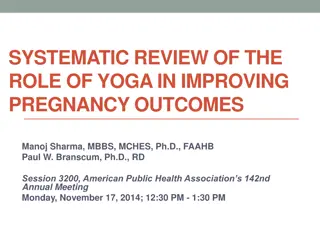Explore the World of Yoga: Types and Techniques
Discover the essence of yoga with insights into different types of yoga practices like Karma, Bhakti, Gyana, and Raja Yoga. Learn about the union of body, mind, and soul through various yoga asana techniques, guided by the wisdom of renowned yoga guru Mrs. S. Anitha. Immerse yourself in the diverse paths towards enlightenment and holistic well-being offered by the Sathyam Institute of Yoga.
Download Presentation

Please find below an Image/Link to download the presentation.
The content on the website is provided AS IS for your information and personal use only. It may not be sold, licensed, or shared on other websites without obtaining consent from the author. Download presentation by click this link. If you encounter any issues during the download, it is possible that the publisher has removed the file from their server.
E N D
Presentation Transcript
SATHYAM INSTITUTE OF YOGA Yoga & Different Types Of Asana Techniques Mrs. S. Anitha Yoga Guru Managing trustee
YOGA DEFINITION The word Yoga is derived from the Sanskrit root Yuj , meaning tojoin or toyoke or to unite . Yoga is the union of body, mind & soul. Body is the first tool we need in any asana practice. Physically, asana is about the certain movement in our limbs which performed to stretch the body, makes it flexible, cures diseases, and enhances overall health. Through asanas, we indeed aim to achieve control over the mind by stabilizing the body.
TYPES OF YOGA There are as many ways to practice yoga as there are to unite with bliss and enlightenment. The primary types of yoga: Karma yoga The Yoga of Actions Bhakti yoga The yoga of Devotion Gyana yoga The yoga of knowledge Raja yoga Royal yoga path Hatha yoga The physical yoga
KARMA YOGA Karma [KAR-muh] yoga is the path of service through selfless action for the good of others. For example, Mother Teresa's works to serve poor people as a way to connect the compassion of God with humanity. Unconditional service is a tradition in Hindu monasteries or ashrams [AAHSH-ruhms], and many yoga teacher training programs require candidates to practice karma yoga by cooking and cleaning or providing other voluntary service for others.
BHAKTI YOGA Bhakti [b-HUHK-tee] yoga cultivates the expression and love of the Divine through devotional rituals. Forms of this path include regular prayer, chanting, singing, dancing, ceremony, and celebration. For example, bhakti yoga is practiced and shared in the uplifting music of renowned kirtan (devotional chant) vocalist and spiritual leader Krishna Das.
GYANA YOGA Gyana yoga is the path of intellect and wisdom, and its components include study of sacred texts, intellectual debates, philosophical discussion, and introspection.
RAJA YOGA Raja [RAAH-juh] yoga, also known as the "royal path," refers to the journey toward personal enlightenment. This path consists of balancing the three main yoga types just described - karma, bhakti, and jnana - while integrating the eight limbs, or stages, of yoga.
HATHA YOGA Hatha [HUH-tuh] yoga is represented as a combination of the third and fourth limbs of the royal path - that is, asana [AAH-suh-nuh] and pranayama [praah-naah-YAAH-muh] Hatha yoga is the type generally practiced in modern (and especially Western) society. The word hatha is usually translated from Sanskrit as "sun and moon," with ha signifying sun energy and tha signifying moon energy. Balancing the active ha energy and the more calming tha energy is the ultimate aim of hatha yoga practice. Hatha is also translated as "forceful"
EIGHTFOLD PATH OF PATANJALI - ASHTANGA YOGA Yama - Restraint Niyama Observance Asana Body postures External Parts Pranayama - Regulation of breath Pratyahara - Abstraction of senses Dharana Concentration Dhyana Meditation Internal Parts Samadhi Self realization
YAMA Yama- Restrains or observances regarding how the aspiring yogi should relate to his or her community. Ahimsa- Non-violence Satya- Truthfulness Asteya- Non-stealing Brahmacharya-Conservation of vital energy Aparigraha- Non-hoarding
NIYAMA Niyama- Intense observances that the aspiring yogi should carry out in his or her daily life in order to have a body and mind suited for Yoga. Saucha- Cleanliness of body and mind Santosha- Contentment Tapas- Discipline Svadhyaya- Self-study Ishvara Pranidhana- Surrender to the Divine
ASANA Asana- The word literally translates to seat . These are postures that promote stillness of mind, and physical postures that facilitate sitting for long periods of time in those postures. Standing Poses Sitting Meditation poses Reclining Poses Inverted Poses Balancing Poses Forward bend Poses Backbend Poses Twisting Poses Hip-opening Poses Core strength Poses
PRANAYAMA "Pranayama is control of Breath". "Prana" is Breath or vital energy in the body. On subtle levels prana represents the pranic energy responsible for life or life force, and "ayama" means control. So Pranayama is "Control of Breath". Five types of prana are responsible for various pranic activities in the body, they are Prana, Apana, Vyan, Udana & Samana. Out of these Prana and Apana are most important. Prana is upward flowing and Apana is downward flowing. Practice of Pranayama achieves the balance in the activities of these pranas, which results in healthy body and mind.
TYPES OF PRANAYAMA Natural Breathing Viloma Interrupted Breathing AnulomVilom Alternate Nostril Basic Abdominal breathing Breathing Thoracic breathing Cooling Breath - Sheetali, Sitkari, Kaki Clavicular breathing mudra Yogic breathing Ujjayi Victorious Breath Deep breathing with ratios Bhramari Humming Bee Breath Fast breathing Bhastrika Bellow s Breath Surya Bhedan Right Nostril Breathing
PRATYAHARA Withdrawal of the senses from things that are not conducive to the practice of Yoga, a moving from the external to internal world. When the 5 senses are quelled, the mind can then become still. Types of Pratyahara Indriya Pratyahara Prana Pratyahara Karma Pratyahara Mano Pratyahara
DHARANA The word Dharana means both the practice of deep concentration and it also is the state of being in which you attain deep concentration. Ideally, dharana should be performed at every moment of the day. It s synonymous with the adage being in the moment Concentrating our attention on one point allows the mind to be stable and calms the disturbance of activity, to which we are used to.
DHYANA Dhyana is a Sanskrit word meaning "meditation." It is derived from the root words, dhi, meaning receptacle or themind ; and yana, meaning moving or going. An alternate root word, dhyai, means "to think of. POPULAR TYPES OF MEDITATION PRACTICE: Mindfulness Meditation Transcendental Meditation Vipassana Meditation Spiritual Meditation Guided Meditation Chakra Meditation Breath Meditation
SAMADHI A super-conscious trance in which the mind merges fully with and becomes one with the object of meditation. In the highest state of Samadhi, there is no longer any object of meditation. In yoga, samadhi is considered to be the state in which individual and universal consciousness unite. It is a blissful form of total meditative absorption, reached once the practitioner has moved through the preliminary steps on Patanjal s eightfold path.
